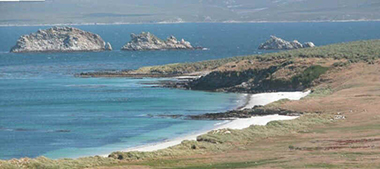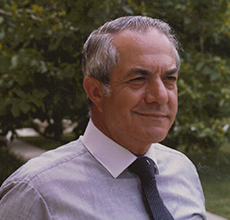CRUISE SHIP LECTURES :
The Falkland Islands in Time, Place and War
Dr John Augelli shares his insight on the Falkland Islands in these notes from one of his cruise ship lectures.
The Falkland Islands in Time, Place and War

Photo: The Falkland Islands, Ladatco Tours
To belabor the obvious we are en route to the Falkland Islands, and more specifically to Port Stanley, the capital city of the colony. I use the word "city" loosely because the entire civilian population (1,600) of the place could be accommodated on the Crystal Harmony without too much cramping. In fact excluding about 2,000 military personnel who have been permanently stationed there since 1982, the total population of all the Falklands, according to the 1996 Census, came to a mere 2,607.
As you already know, the Argentines who still claim the Falklands call them "las Islas Malvinas", and it may be useful to clarify the difference in nomenclature at the start. The English name was given in honor of Viscount Falkland, a Treasurer of the Royal Navy in the seventeenth century. The Spanish name "Malvinas" is derived from the French "Malouines", the name given the islands by those shipping out of the French Breton port of St. Malo, the starting point of many ships headed for the South Seas in the colonial period.
Getting back to the Falklands, you may conclude otherwise after our visit, but the image that most observers have of the islands is that they are windy, gloomy, bleak and inhospitable, not unlike Tierra del Fuego or the Aleutians of Alaska. As far back as 1771, Dr. Samuel Johnson wrote of them as "...a few spots of earth which almost escape human notice .... stormy in winter and barren in summer, islands that not even the southern savages dignified with human habitation."
But don't despair yet. Dr. Johnson never came to these latitudes at this time of the year, nor did he have the Crystal Harmony as a base of operations. You may find environmental reality ashore a bit more agreeable, especially if you have the instincts of a naturalist, and are fascinated by exceptional flora and fauna. At any rate, permit me to draw you a thumbnail sketch of physical conditions on the islands, followed by an equally brief historical and socio-economic summary before touching on the Falklands War of 1982.
Environment
The Falklands archipelago consists of two principal islands (East and West Falkland) and some 200 smaller islands with a total area of 4,700 square miles. They are located between 52 and 53 degrees south latitude, 300 miles east of Rio Gallegos in Argentina, 480 miles northeast of Cape Horn and 7,000 miles from Britain. The lowlands on the islands tend to be poorly drained and boggy, making overland travel challenging even by horseback or 4-wheel drive vehicles. (Incidentally, most vehicles are land rovers, and it is said that the islands have the highest ratio of vehicles to inhabitants in the world.) The bogs yield peat which has been the traditional fuel used for heating and cooking, but the use of gas is increasing. The uplands on the main islands consist of rolling rocky hills, flanked by sea cliffs and terraces, and interrupted by "stone runs", fields of large angular blocks of quartzite.
Climatically, the Falklands are affected by the proximity of the Antarctic ice mass; and location in the open ocean, directly in the path of the prevailing Westerleys. The result is an extreme marine climate roughly comparable to that of northernmost Scotland. There is little temperature change between winter and summer, and the same kind of clothing may be worn year-round. No month is totally frost-free; snow has been recorded in every month except January and February; the mean annual temperature is 46 degrees F; and because of the frequent gale force winds, the sensitive temperature (or wind chill factor) can be uncomfortable at any time of the year.
Given this climatic regime with a short growing season, the islands are naturally treeless. Some trees have been planted around houses or as windbreaks in the fields, but these have to be tended.
Partly because of climate and partly because of highly acidic soils, agriculture is limited to a few cool weather crops such as potatoes, turnips and cabbage which are usually grown on house garden plots. Oats are planted, but they often fail to mature because of a short growing season.
The natural vegetation or flora of the archipelago tends to grass, bushes and lichens – hence the presence of some 700,000 sheep. The nutritious tussock grasses that once abounded on the main islands have been overgrazed almost to extinction. There is still an abundance of less nutritious white grass which is adequate fodder for sheep. In addition, there are about 150 species of flowering plants, including the yellow gorse imported from Scotland.
The Falklands have long attracted naturalists interested in birdlife. Approximately 126 species of birds have been identified, of which 61 are permanent residents. Among the bird population are several species of penguins, including the king; upland geese; flightless steamer ducks and albatrosses. Fur seals and sea lions may still be found, but the huge herds that once came here were decimated by the unrestricted hunting of the 18th and 19th centuries.
Despite this restricted environment, the post-Columbian history of the Falklands has been a convoluted one, especially since the 18th century. It is possible that they were first sighted by Amerigo Vespucci, the Florentine navigator from whose name "America" is derived. After Vespucci, other Europeans stumbled on the islands, but it was not until 1764 that a young Frenchman named Louis Antoine de Bougainville, desirous of making up for the loss of Canada to England after the French and Indian Wars, established the first colony on the islands. The settlement, located on the northeast corner of East Falklands was called Port Louis. Interestingly, the first settlers were two refugee families from Acadia (Nova Scotia) made famous by Longfellow's "Evangiline". Nearly 100 French families were living on the Falklands when they were sold to Spain in 1767. (The transfer was made because France recognized Spain's ownership of the islands based on the Treaty of Tordesillas 1494 Explain.)
At the same time that the Spaniards took over from the French, the English established themselves at Ft. Egmont on Saunders Island. The Protestant English refused to recognize Spanish sovereignty based on Tordesillas. As a result, Spain seized Egmont in 1770, and the two countries almost came to war. Later (Jan. 1771) Spain agreed to restore Egmont to England, but stated that this in no way affected Spanish rights of sovereignty over the Malvinas. In turn, the English abandoned Egmont in 1774 for economic reasons, leaving the islands to Spain.
The Spaniards remained in the Malvinas for some 40 years until the outbreak of the Wars of Independence in 1811, but the number of settlers was never more than 90 people during the Spanish occupation, although the number of cattle, horses and other livestock grew to 8,000.
Following independence, the Argentines claimed sovereignty derived from the Spanish claim over the Malvinas. After 1820, they sent over gauchos and a few Indians to raise cattle on the islands despite British protests. In 1833, the British took over the Argentine settlement by force, and the stage was set for future disputes. The British established a civil administration on the Falklands, and began to send a small number of settlers. It was from these settlers that the current civilian population of the Falklands is derived.
During the 19th century, sealing and whaling ships began to call at the Falklands primarily to hunt cattle and sheep for supplies. For a while the islands, and particularly Port Stanley, thrived as a supply and repair base. (The islanders also developed a shady reputation for preying on wrecked vessels.) The prosperity was shortlived. The rise of Puntarenas in Chile and later (1914) the opening up of the Panama Canal reduced the importance of the Falklands, and restricted the insular population.
Society
Of the total Falklands civilian population of 2,607 recorded by the 1996 Census, almost 2/3 (63%) live in Port Stanley, and the remainder in the "camp" or rural areas.
Life on the Falklands can be rugged, even primitive, especially in the camps and on the outer islands. Weather plays a key role. Bad weather can isolate camp settlements for days on end. In the winter, trails from the camp settlements become impassable, and the only way to reach a settlement is by boat or bush plane. For this reason and in order to facilitate loading wool on ships camp settlements are located near water. The two way radio is the camp lifeline. Every settlement has a receiver and a transmitter. The receivers are always turned on to pick up information from Stanley and other settlements. Doctors in Stanley diagnose ailments and prescribe remedies by radio; and even teaching of school children is often done by radio. Although no child between 5 and 15 is out of a school situation, educational standards are low. In addition to the radio, there are itinerant teachers who go from settlement to settlement, visiting each one for 14 days every two months. Also in the camp, there are chronic shortages of labor, especially at sheep-shearing time. Women often pitch in to help, but laborers are regularly imported from Chile. Still, the labor force tends to dwindle as many of the young men leave for Australia, New Zealand and the U.K.
The difficulty of finding mates is one reason why the young men leave. In West Falkland in 1975, for example, there was only one unmarried woman of 19. Ten women had left the year before to become engaged to marry Royal Marines.
Life in Stanley is a bit more comfortable than in the camp but not much. Stanley has been likened to the villages of the northern Scottish islands. The town, with its neat rows of framed houses, each with its potted plants, seems out of place off the coast of Patagonia. There are about 20 miles of paved roads in and around Stanley, but beyond the town, roads are either non-existent or primitive. Most entertainment in the town centers on the home, but weekly dances are held in the Town Hall. There are several pubs that keep normal British hours, but are open from noon to 1 PM on Sunday. This is known as the glory hour. Soccer is the most popular sport. Still, isolation and lack of entertainment and shortage of young women make life on the islands monotonous.
There are social class differences in the Falklands population. About 20% of the people are expatriates (expats). They are Britons who have come on short term contracts. Among themselves, they constitute a homogeneous group, but in most respects, they are foreigners among the islanders. The expats make up the social elite, and the islanders are ranked by the positions they hold.
Economy
It's tough to make a living in the Falklands. Despite some improvement and diversification that have occurred since the war in 1982, the Falklands economy continues to be dominated by the production and export of high grade sheep wool. Grazing land constitutes about 2/3 of the islands' area, and before the war, it was concentrated into 36 ranches ranging in size from 1.000 to 350,000 acres. Of these only 4 were owner-occupied, 9 belonged to partnerships based in Stanley, and the rest (23) were owned by companies headquartered in Britain. The sheep companies, especially the huge Falklands Island Co., dominated the economy. The islanders who worked for the companies generally received housing, meat, milk and fuel plus from $6,000 to $8,000 per year--a comfortable living. But most benefits including housing were lost upon retirement. The retirees and their families moved to Stanley, and as a result, camp settlements had virtually no older people.
The war ushered in some changes. In 1997, for example, there were 100 ranches instead of 36; the Falklands Co. had sold some of its land to the government. There are also some minor industries and fishing; tourism brings about 5,000 visitors per year; oil explorations are ongoing providing some hope for the future; there is sale of international fishing licenses; and the British military employ some 400 workers, many of them expats.
It was these remote, wind-swept tiny pieces of real estate that exploded onto the world's center stage on April 2, 1982, with the announcement that Argentine military forces had occupied them. The armed conflict between Britain and Argentina that ensued for the next 74 days was one more stage of a dispute over sovereignty of the islands that goes back to colonial times. As usual in such cases, each side can trot out carloads of arguments in support of its position. Argentina's claim is based primarily on the purchase of the islands by Spain from France in 1766; the rights of succession from Spain at the time of Argentina's independence; and the continuous occupation of the islands by Argentina from 1820 until the British attack in 1833. The British argue that, despite Spain's assertion to the contrary, the sovereignty over the Falklands passed to Britain in the agreement of 1771. The British further point to the continuous and peaceful occupation of the islands since 1833; and to the rights of self determination of the islanders who are mostly of British descent. While unspoken, the issue between the two countries is further complicated by evidence of oil and gas deposits under the archipelago's territorial waters.
At the start of the war, most Britons didn't know what and where the Falklands were. But the war quickly became a media event in Britain, almost at par with the later death of Princess Diana. In contrast the Argentines were completely aware of the islands because they had been taught from childhood that "las Islas Malvinas son Argentinas". And the dispute over the islands was and continues to be a major factor in Argentina's foreign policy.
Why did Britain that had disengaged itself peacefully from a vast empire find it necessary to go to war over what one journalist described as "a rock with the population of an English village living on it"? Why did Britain and Argentina linked by more than 150 years of strong historical, commercial and cultural ties find themselves at war? (In 1930, for example, Argentina was considered to be an unofficial dominion of the British Commonwealth.)
There are no rational answers to these questions. In Britain political and jingoistic forces were released in the wake of a sudden, unexpected and humiliating loss of a British possession. It proved difficult for PM Thatcher's government, beleaguered by economic and other difficulties and performing badly in the opinion polls, to avoid reaction. In Argentina, the military dictatorship of Galatieri, also beleaguered by the country's economic woes, by human rights and other problems and by anti-government riots, gave in to temptation and allowed national pride to unite the country for a brief moment. Few Argentines considered the negligible utility of the islands because they were far less important in themselves than as an emotional national symbol.
And so the British mounted "Operation Corporate": they landed at San Carlos on May 21, and proceeded to reoccupy the Falklands following the Argentine surrender. The United States caught by surprise by the war's outbreak vacillated between the pressure of public opinion in Latin America and the traditional ties to Britain. Ultimately, President Reagan influenced by Casper Weinberg and Alexander Haig and under pressure from Margaret Thatcher openly sided with the British, but not without serious damage to hemispheric relations. In fact, Jean Fitzpatrick observed that the U.S. lost more than either Britain or Argentina in the war.
Immediate results of the War: In Britain, it reinforced Margaret Thatcher's political image and allowed her to win a decisive victory at the polls in 1983; in Argentina, it toppled the military dictatorship and intensified the economic woes and inflation.
Otherwise, the war changed little. Argentina still claims the islands and is determined to get them back by any means. In fact, some observers are already referring to the 1982 clash as merely the first Malvinas War, implying that there will be others. The guns stopped firing in June of 1982, but the Argentines won't allow the issue to die and bring it up regularly. In the face of the Argentine stance, Britain is saddled with the hefty cost of maintaining 2,000 troops on the islands. The two countries finally resumed diplomatic relations in 1990, but the old ties are gone. Perhaps the only winners are the Falkland islanders themselves in that Britain is paying more attention to them, and the insular economy has improved.
In 1984, a British pundit satirized the Falklands affair as follows: "Once upon a time down at the bottom of the world, there was a sad little island. No one lived on the island except a few poor shepherds.... Next door was a great big kingdom ruled by a wicked Foreign General – he was made of tin pots. His capture of the islands was opposed .... by an old woman made of iron who lived far away and wanted to bagsy the little islands back again." Some of the British may have thought this satire funny, but the Argentines didn't. And perhaps if they could speak, neither would the almost 1,000 young men who died in the Falklands conflict.

